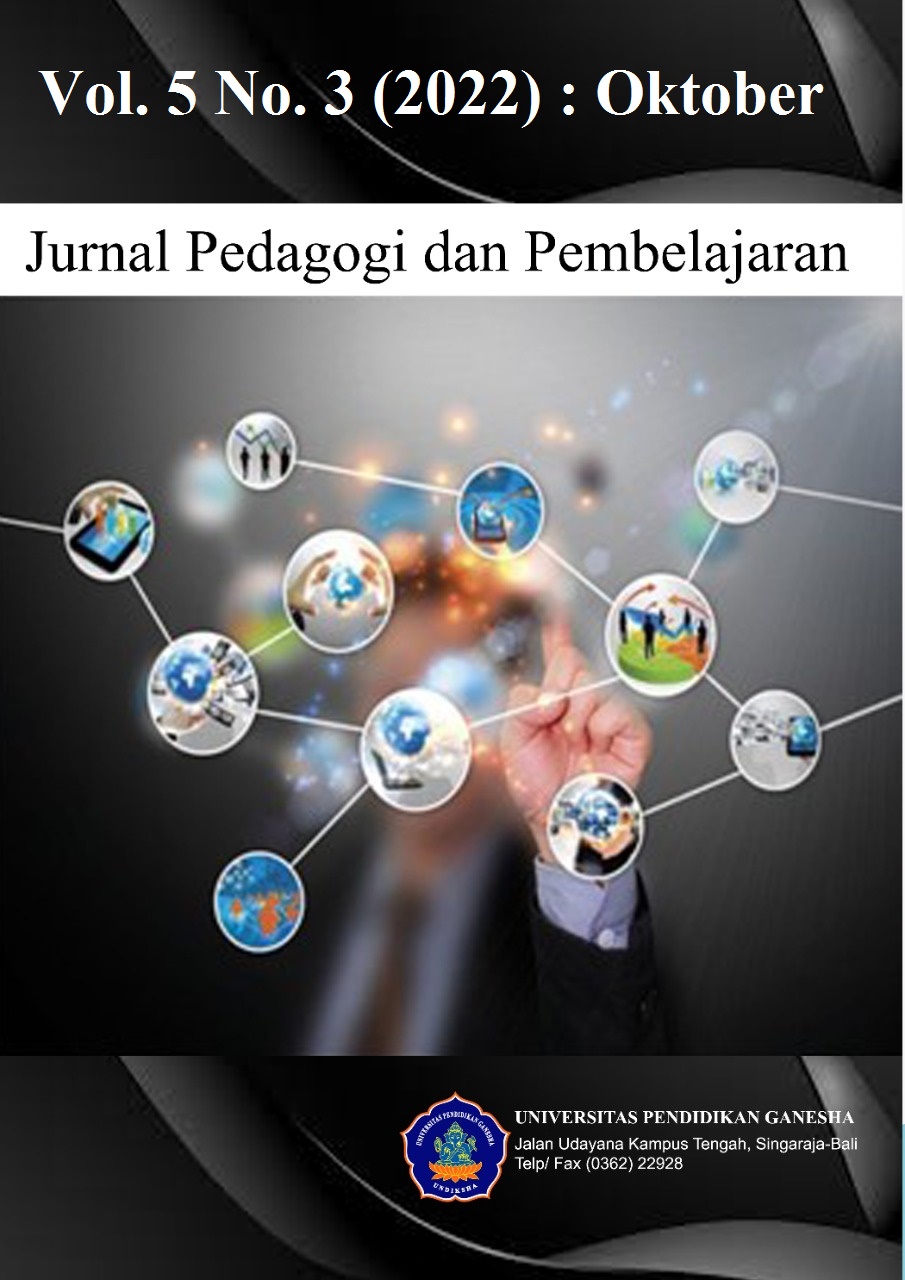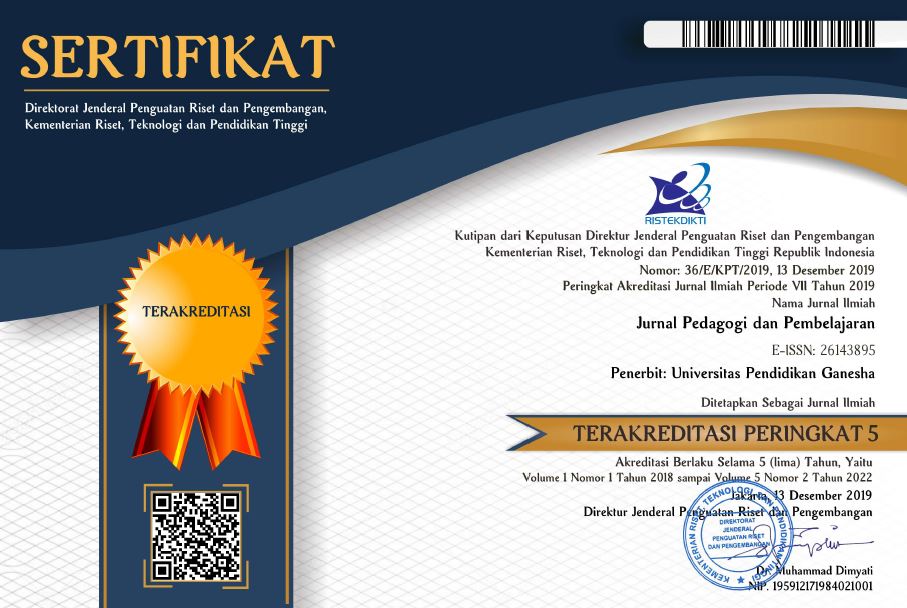Students’ Perception Toward the Efl Lecturer’s Code-Switching in PGSD’S English Classroom
DOI:
https://doi.org/10.23887/jp2.v5i3.43391Keywords:
EFL classroom, code-switching, students'perceptionAbstract
Primary school is the foundation of formal schooling which can affect the aftermath. This study analyses the perception of Primary school teacher education or PGSD student toward the code-switching made by EFL lecturers in English classrooms and the benefits for them in learning English. This study using a mixed-method, the eligible participant received questionnaire and semi-structured interview protocols were carried out in the Indonesian language. The data from the questionnaire was analyzed by Likert scale and the semi-structured interview was analyzed by thematic analysis. The findings showed that first, students have a positive perception toward the code-switching done by the lecturer in English classroom; second, benefits that the students get from code-switching in English classroom are increase the level of English vocabulary capacity mastery, help in understanding lessons, learn the English language better, help understanding course assignments, improves English speaking skill, improves English listening skill. As the conclusion, the code-switching used for teaching English in the classroom had given great impact on PGSD students which is most of the students showed a positive perception toward the used of Code-switching.
References
Ansar, F. A. (2017). Code switching and code mixing in teaching-learning process. English Education: Jurnal Tadris Bahasa Inggris, 10(1), 29–45. https://doi.org/10.24042/ee-jtbi.v10i1.873.
Bahous, R. N., Nabhani, M. B., & Bacha, N. N. (2014). Code-switching in higher education in a multilingual environment: a Lebanese exploratory study. Language Awareness, 23(4), 353–368. https://doi.org/10.1080/09658416.2013.828735. DOI: https://doi.org/10.1080/09658416.2013.828735
Bhatti, A., Shamsudin, S., & Said, S. B. M. (2018). Code-Switching: A Useful Foreign Language Teaching Tool in EFL Classrooms. English Language Teaching, 11(6), 93–101. https://doi.org/10.5539/elt.v11n6p93. DOI: https://doi.org/10.5539/elt.v11n6p93
Bokamba, E. G. (1989). Are there syntactic constraints on code-mixing? World Englishes, 8(3), 227–292. https://doi.org/10.1111/j.1467-971X.1989.tb00669.x. DOI: https://doi.org/10.1111/j.1467-971X.1989.tb00669.x
Braun, V., & Clarke, V. (2006). Using thematic analysis in psychology. Qualitative Research in Psychology, 3(2). https://doi.org/10.1191/1478088706qp063oa. DOI: https://doi.org/10.1191/1478088706qp063oa
Creswell, J. W. (2014). Research Design: Qualitative, Quantitative and Mixed Methods Approaches (4th ed). Sage.
Fachriyah, E. (2017). The functions of code switching in an English language classroom. Studies in English Language and Education, 4(2), 148–156. https://doi.org/10.24815/siele.v4i2.6327. DOI: https://doi.org/10.24815/siele.v4i2.6327
Fanani, A., & Ma’u, J. A. R. Z. (2018). Code switching and code mixing in English learning process. Ling Tera, 5(1), 68–77. https://doi.org/10.21831/lt.v5i1.14438. DOI: https://doi.org/10.21831/lt.v5i1.14438
Fathimah, D. N. (2016). Why Is There Code Switching In Efl Classroom?: A Case Study In A Vocational School In Cimahi West-Java. Jurnal Pendidikan Bahasa dan Sastra, 16(1), 70–77. https://doi.org/10.17509/bs_jpbsp.v16i1.3063.
Fathimah, Diana Nur. (2016). Why Is There Code Switching in Efl Classroom? : a Case Study in a Vocational School in Cimahi West-Java. Jurnal Pendidikan Bahasa dan Sastra, 16(1), 70. https://doi.org/10.17509/bs_jpbsp.v16i1.3063. DOI: https://doi.org/10.17509/bs_jpbsp.v16i1.3063
Kasim, U., Yusuf, Y. Q., & Ningsih, S. R. J. (2019). The types and functions of code switching in a thesis defense examination. EduLite: Journal of English Education, Literature and Culture, 4(2), 101–118. https://doi.org/10.30659/e.4.2.101-118. DOI: https://doi.org/10.30659/e.4.2.101-118
Koban, D. (2013). Intra-sentential and inter-sentential code-switching in Turkish-English bilinguals in New York City, US. Procedia-Social and Behavioral Sciences, 70, 1174–1179. https://doi.org/10.1016/j.sbspro.2013.01.173. DOI: https://doi.org/10.1016/j.sbspro.2013.01.173
Kuzyk, O., Friend, M., Severdija, V., Zesiger, P., & Poulin-Dubois, D. (2020). Are there cognitive benefits of code-switching in bilingual children? A longitudinal study. Bilingualism: Language and Cognition, 23(3), 542–553. https://doi.org/10.1017/S1366728918001207. DOI: https://doi.org/10.1017/S1366728918001207
Lee, H. L. J. (2016). Code switching in the teaching of English as a second language to secondary school students. Malaysian Journal of ELT Research, 6(1), 45. https://doi.org/10.21013/jems.v4.n1.p10. DOI: https://doi.org/10.21013/jems.v4.n1.p10
Lin, A. (2013). Classroom code-switching: Three decades of research. Applied Linguistics Review, 4(1), 195–218. https://doi.org/10.1515/applirev-2013-0009. DOI: https://doi.org/10.1515/applirev-2013-0009
Mabule, D. R. (2015). What is this? Is it code switching, code mixing or language alternating? Journal of Educational and Social Research, 5(1), 339. https://doi.org/10.5901/jesr.2015.v5n1p339. DOI: https://doi.org/10.5901/jesr.2015.v5n1p339
Moetia, M. (2018). Code mixing and code switching in the classroom interaction. English Education Journal, 9(2), 229–242.
Mustikawati, D. A. (2016). Code-Mixing and Code Switchingin The Process of Learning. Register Journal, 9(1), 24–51. https://doi.org/10.18326/rgt.v9i1.24-51. DOI: https://doi.org/10.18326/rgt.v9i1.24-51
Nurhamidah, N., Fauziati, E., & Supriyadi, S. (2018). Code-Switching in Efl Classroom: Is It Good or Bad? Journal of English Education, 3(2), 78–88. https://doi.org/10.31327/jee.v3i2.861. DOI: https://doi.org/10.31327/jee.v3i2.861
Puspawati, I. (2018). Teachers ’ Use of Code Switching in EFL Classroom and its Functions. Journal of Foreign Language Teaching and Learning, 3(1), 73–74. https://doi.org/10.18196/ftl.3128. DOI: https://doi.org/10.18196/ftl.3128
Rahmat, A. (2020). Code Mixing in EFL Classroom: Views from English Teachers Side. Al-Lisan: Jurnal Bahasa (e-Journal), 5(2), 130–147. https://doi.org/10.30603/al.v6i2.1323. DOI: https://doi.org/10.30603/al.v6i2.1323
Reyes, I. (2004). Functions of code switching in schoolchildren’s conversations. Bilingual research journal, 28(1), 77–98. https://doi.org/10.1080/15235882.2004.10162613. DOI: https://doi.org/10.1080/15235882.2004.10162613
Rojabi, A. R. (2020). Exploring EFL Students’ Perception of Online Learning via Microsoft Teams: University Level in Indonesia. English Language Teaching Educational Journal, 3(2), 163. https://doi.org/10.12928/eltej.v3i2.2349. DOI: https://doi.org/10.12928/eltej.v3i2.2349
Selivanova, O. G., Gromova, C. R., & Mashkin, N. A. (2018). Improving student motivation for learning the second foreign language. XLinguae, 11(1), 218–229. https://doi.org/10.18355/XL.2018.11.01.18. DOI: https://doi.org/10.18355/XL.2018.11.01.18
Siddiq, R. A., Kustati, M., & Yustina, L. S. (2020). Teachers’ code mixing and code switching: insights on language barriers in efl classroom. Al-Ta lim Journal, 27(1), 80–91. https://doi.org/10.15548/jt.v27i1.606. DOI: https://doi.org/10.15548/jt.v27i1.606
Suganda, L. A., Loeneto, B. A., & Zuraida, Z. (2018). Teachers’ Use of Code Switching in An English as a Foreign Language Context in Indonesia. Script Journal: Journal of Linguistic and English Teaching, 3(2), 111. https://doi.org/10.24903/sj.v3i2.202. DOI: https://doi.org/10.24903/sj.v3i2.202
Sugiyono. (2018). Metode Penelitian Kombinasi (Mixed Methods). CV Alfabeta.
Sujana, A., & Rachmatin, D. (2019). Literasi digital abad 21 bagi mahasiswa PGSD: apa, mengapa, dan bagaimana. Conference Series Journal.
Sukmawati, S., & Nensia, N. (2019). The Role of Google Classroom in ELT. International Journal for Educational and Vocational Studies, 1(2). https://doi.org/10.29103/ijevs.v1i2.1526. DOI: https://doi.org/10.29103/ijevs.v1i2.1526
Van Hell, J. G., Litcofsky, K. A., & Ting, C. Y. (2015). Intra-sentential code-switching: Cognitive and neural approaches. The Cambridge handbook of bilingual processing, 459–482. https://doi.org/10.3389%2Ffpsyg.2021.660695. DOI: https://doi.org/10.1017/CBO9781107447257.020
Waris, A. M. (2012). Code switching and mixing (Communication in Learning Language). Jurnal Dakwah Tabligh, 13(1), 123–135. https://doi.org/10.24252/jdt.v13i1.299.
Widodo, A., Indraswasti, D., Erfan, M., Maulyda, M. A., & Rahmatih, A. N. (2020). Profil minat baca mahasiswa baru PGSD Universitas Mataram. Premiere Educandum, 10(1). https://doi.org/10.25273/pe.v10i1.5968. DOI: https://doi.org/10.25273/pe.v10i1.5968
Yao, M. (2011). On attitudes to teachers’ code-switching in EFL classes. World journal of English language, 1(1), 19. https://doi.org/10.5430/wjel.v1n1p19. DOI: https://doi.org/10.5430/wjel.v1n1p19
Downloads
Published
How to Cite
Issue
Section
License
Copyright (c) 2022 Hasanuddin Fatsah, Indah Purnama

This work is licensed under a Creative Commons Attribution-ShareAlike 4.0 International License.
Authors who publish with Jurnal Pedagogi dan Pembelajaran agree to the following terms:- Authors retain copyright and grant the journal the right of first publication with the work simultaneously licensed under a Creative Commons Attribution License (CC BY-SA 4.0) that allows others to share the work with an acknowledgment of the work's authorship and initial publication in this journal
- Authors are able to enter into separate, additional contractual arrangements for the non-exclusive distribution of the journal's published version of the work (e.g., post it to an institutional repository or publish it in a book), with an acknowledgment of its initial publication in this journal.
- Authors are permitted and encouraged to post their work online (e.g., in institutional repositories or on their website) prior to and during the submission process, as it can lead to productive exchanges, as well as earlier and greater citation of published work. (See The Effect of Open Access)













